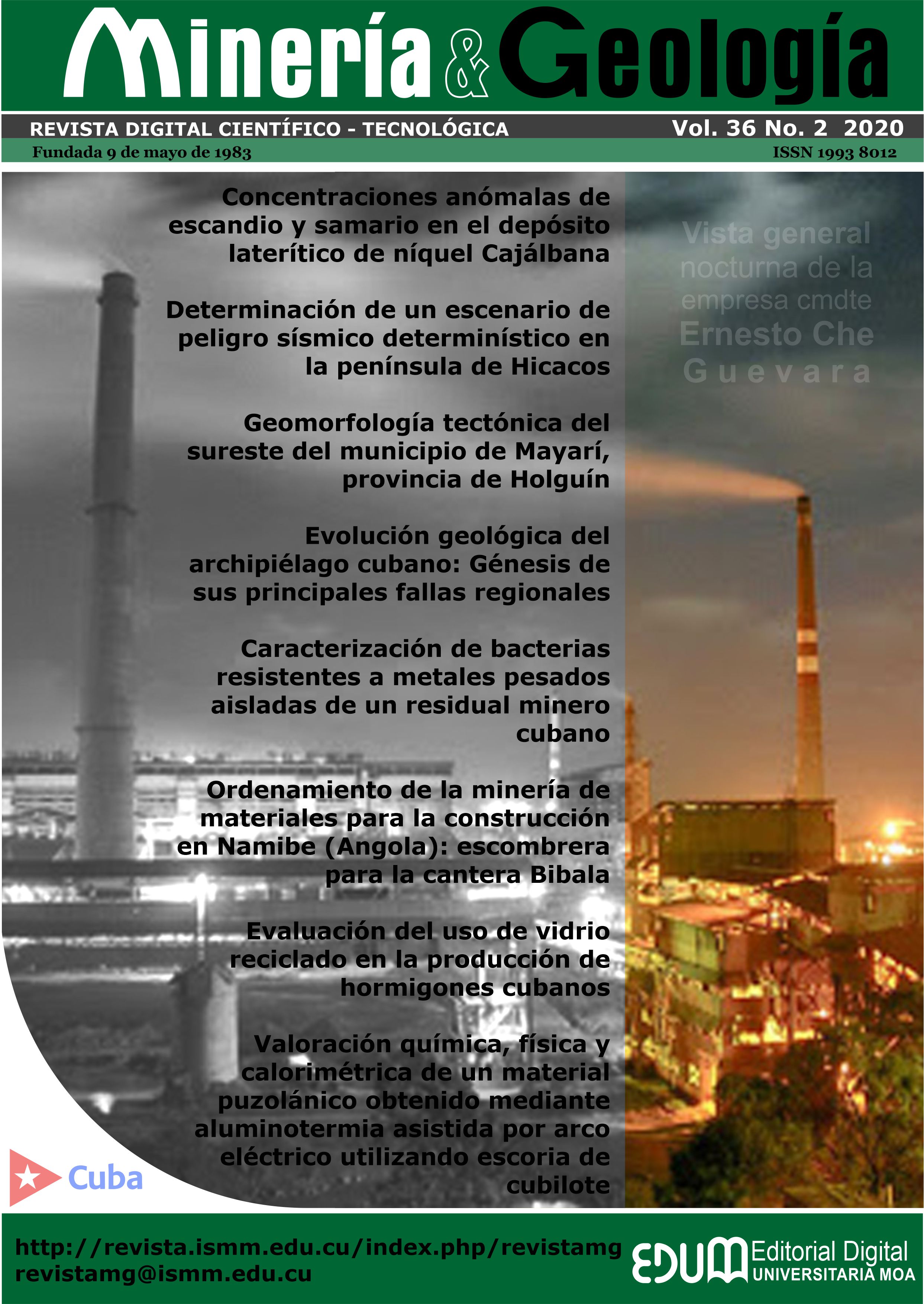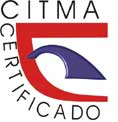Characterization of heavy metals resistant bacteria isolated from a Cuban mining waste
Keywords:
Bacillus, lateritic rubble, resistance to heavy metals, bioremediation.Abstract
Environmental pollution by heavy metals is a contemporary world problem. Developing biotechnological strategies in remediation field has gained great attention in recent years for being more profitable, efficient and friendly to the environment. Heavy metal resistant bacteria are a powerful tool in bioremediation of metal contaminated environments. The aim of this study is to characterize heavy metal resistant bacteria, isolated from lateritic rubble, residual from Moa mining industry. Two bacteria (EL-1 and EL-2) were isolated from the lateritic rubble. The isolated ones were characterized and identified down to gender level. Resistance to nickel, cobalt, chromium and aluminum was evaluated in solid Tri minimal medium. The dose-response curve for nickel, cobalt, chromium and aluminum was determined, as well as the mechanism of bacterial resistance to nickel. In addition, antibiotic susceptibility was assessed. The two isolated were identified as Bacillus sp. The strains were resistant to all the evaluated metals, showing a high resistance to nickel (25 mmol-L-1). The Bacillus sp. EL-1 showed an induced mechanism of nickel resistance, while the Bacillus sp. EL-2 showed a constitutive resistance to this metal. The bacteria showed a predominance of sensitivity to the antibiotics evaluated. All these characteristics make them interesting to be applied in bioremediation strategies for environmental cleanup.Downloads
References
ABOU-SHANAB, R.A.I.; VAN BERKUM, P. & ANGLE, J.S..2007: Heavy metal resistance and genotypic analysis of metal resistance genes in gram-positive and gram-negative bacteria present in Ni-rich serpentine soil and in the rhizosphere of Alyssum murale. Chemosphere. 68: 360-367.
ADEKANMBI, A. O.; ADELOWO, O. O.; OKOH I. A. & FAGADE O. E.. 2019: Metal-resistance encoding gene-fingerprints in some bacteria isolated from wastewaters of selected printeries in Ibadan, South-western Nigeria. Journal of Taibah University for Science. 13 (1): 266-273.
ALI, H.; KHAN, E. & ILAHI, I. 2019: Environmental Chemistry and Ecotoxicology of Hazardous Heavy Metals: Environmental Persistence, Toxicity, and Bioaccumulation. Hindawi Journal of Chemistry. ID 6730305. https://doi.org/10.1155/2019/6730305.
ARGUDÍN M.A., HOEFER A. & BUTAYE P.. 2019: Heavy metal resistance in bacteria from animals. Research in Veterinary Science. 122:132–147.
AZAM, M.; TASLEEM, A.; KUMAR, A.; SIDDIQUI, K.; MONDAL, A. H. & HAQ, R.. 2018: Study of pandrug and heavy metal resistance among E. coli from anthropogenically influenced Delhi stretch of river Yamuna. Brazilian Journal of Microbiology. 49:471-480.
BANJERDKIJ, P.; VATTANAVIBOON P. & MONGKOLSUK S.. 2003: Cadmium-induced adaptive resistance and cross-resistance to zinc in Xanthomonas campestris. Curr Microbiol. 47: 260–262.
BARZANTI, R.; OZINO, F.; BAZZICALUPO M.; GABBRIELLI R.; GALARDI F.; GONNELLI C. & MENGONI A.. 2007: Isolation and characterization of endophytic bacteria from the nickel hyperaccumulator plant Alyssum bertolonii. Microb. Ecol. 53(2): 306-316.
BAUER, A.W.; KIRBY M.M.; SHERRIS, J.C. & TRUCK, M.. 1966: Antibiotic susceptibility testing by a standardized single disk method. Am J Clin Pathol 42: 493.
BAZAN, G. & GALIZIA, G.. 2018: Geographical and ecological outline of metal (loid) accumulating plants in Italian vascular flora. Ecocycles 4(1): 47-64.
BRESSON, C.; DAROLLES, C.; CARMONA, A.; GAUTIER, C.; SAGE, N.; ROUDEAU, S.; ORTEGA, R.; ANSOBORLO, E. & MALARD, V.. 2013: Cobalt chloride speciation, mechanisms of cytotoxicity on human pulmonary cells, and synergistic toxicity with zinc. Metallomics. 5 (2): 85-176.
DÍAZ, A. 2013: Caracterización de la resistencia a metales de una colección bacteriana aislada del yacimiento niquelífero de Moa (Cuba) y sus potencialidades en la biorremediación ambiental de sitios contaminados por metales pesados. Jeannette Marrero Coto, José Manuel Gómez Montes de Oca, Gema Cabrera Revuelta (Tutores). Tesis Doctoral. Universidad de Cádiz. 249p.
DIELS, L.; VAN ROY, S.; TAGHAVI, S. & VAN HOUDT, R.. 2009: From industrial sites to environmental applications with Cupriavidus metallidurans. Antonie Van Leeuwenhoek. 96(2):247-58.
FAROOQ, U., KOZINSKI, J.A., AIN, K.M. & MAKSHOOF, A.. 2010: Biosorption of heavy metal ions using wheat based biosorbents. A review of the recent literature. Bioresource Technology. 101: 5043–5053.
GARCIDUEÑAS, R. P. & CERVANTES, C. (1996) Microbial interactions with aluminium. BioMetal. 9: 311- 316.
GOVIN, A.; COTO, O. & MARRERO J.. 2015: Caracterización fenotípica de una colección bacteriana aislada del yacimiento laterítico de Yagrumaje Norte, Moa, Cuba. Revista Cubana de Ciencias Biológicas 4(1):69-77.
HARRIGAN, W.F. & MCCANCE, M.E.. 1968: Métodos de Laboratorio en Microbiología. Editorial Académica. España: 62-78.
HERNÁNDEZ, I.; GALIZIA, F.; COTO, O. & DONATI, E.. 2009: Improvement in metal recovery from laterite tailings by bioleaching. Advanced Materials Research. 71-73: 489-492.
LOGAN, N. A. & DE VOS, P.. 2007: Genus I. Bacillus. En: Brenner et al. (Eds) Bergey´s Manual of Systematic Bacteriology. 2da Edición. The Firmicutes, 21-127.
LÓPEZ, D. P.; TORRES-CAYCEDO, M. I. & PRADA-QUIROGA, C. F.. 2015: Genes de resistencia en bacilos Gram negativos: Impacto en la salud pública en Colombia. Rev Univ.Salud.18(1):190-202.
MADIGAN, J., MARTINKO B. & PARKER J.. 2019: Microbial Growth and Its Control. En: Biology of Microorganisms. Ed. Prentice Hall, New Jersey, 1058 p.
MARGESIN, R & SCHINNER, F.. 1996: Bacterial heavy metal tolerance extreme resistance to nickel in Arthrobacter spp. Strains. Basic Microbiol.36: 269–282.
MARRERO, J.. 2008: Estudio molecular de la resistencia a níquel y cobalto en Serratia marcescens cepa C-1. Dra. Lila Castellanos Serra, Dr. Dietrich Nies (Tutores). Universidad de La Habana. 103p.
MARRERO, J.; AULING, G.; COTO, O. & NIES, D. H.. 2007: High-Level Resistance to Cobalt and Nickel but Probably No Transenvelope Efflux: Metal Resistance in the Cuban Serratia marcescens strain C-1. Microbial Ecology. 53: 123–133.
MARRERO, J.; COTO, O. & SCHIPPERS, A.. 2016: Anaerobic and aerobic reductive dissolution of iron-rich nickel laterite overburden by Acidithiobacillus Hydrometallurgy. 10.1016/j.hydromet.2016.08.012.
MARZAN, L. W.; HOSSAIN, M.; MINA S. K.; AKTER Y. & MASUDUL A. M.. 2017: Isolation and biochemical characterization of heavy-metal resistant bacteria from tannery effluent in Chittagong city, Bangladesh: Bioremediation viewpoint. Egyptian Journal of Aquatic Research and Fisheries. 43: 65–74.
MERGEAY, M.; NIES L. D., SCHLEGEL H.G., GERITS J., CHARLES P. & VAN GIJSEGEM F.. 1985: Alcaligenes eutrophus CH34 Is a Facultative Chemolithotroph with Plasmid-Bound Resistance to Heavy Metals. J Bacteriol. 162(1): 328-334.
NIES D. H.. 2000: Heavy metal resistant bacteria as extremophiles: molecular physiology and biotechnological use of Ralstonia sp. CH34. Extremophiles. 4: 77–82.
NIES D. H.. 2003: Efflux-mediated heavy metal resistance in prokaryotes. FEMS Microbiol Rev. 27: 313-339.
NWAGWU, C. E., MOLTONG, V., EUCHARIA, N. & ONWUMERE, G. B.. 2017: Isolation and characterization of heavy metal tolerant bacteria from Panteka stream, Kaduna, Nigeria and their potential for bioremediation. African Journal of Biotechnology. 16(1):32-40.
PAL, C.; BENGTSSON-PALME J.; KRISTIANSSON E. & JOAKIM LARSSON D. G.. 2015: Co-ocurrence of resistance genes to antibiotics, biocides and metals reveals novel insights into their co-selection potential. BMC Genomics. 16:964.
PALACIOS, A. & GARCÍA, E.. 2014: Extracción de cobalto de escombros lateríticos mediante lixiviación ácida. Minería y Geología. 30 (2): 73-86.
REEVES, R.; BAKER, A.J.M.; BORHIDI, A. & BERAZAIN R.. 1999: Nickel hiperaccumulation in the serpentine flora of Cuba. Annals of Botany. 83: 29-38.
SAMANTA, A.; BERA P.; KHATUN M.; SINHA C.; PAL P.; LALEE, A. & MANDAL, A.. 2012: An investigation on heavy metal tolerance and antibiotic resistance properties of bacterial strain Bacillus sp. isolated from municipal waste. Journal of Microbiology and Biotechnology Research. J. Microbiol. Biotech. Res. 2 (1):178-189.
SCHEDLBAUER J. L.. 2015: Serpentine ecosystem responses to varying water availability and prescribed fire in the U.S. Mid-Atlantic region. Ecosphere. 6(7):108. http://dx.doi.org/10.1890/ES14-00528.1.
SIDHU, A. K.; METKAR, G. J.; NANDURIKAR, S. P. & PATIL, S. N.. 2015: An Investigation on Metal Tolerance and Antibiotic Resistance Properties of Bacterial Strains Isolated From Two Different Drinking Water Sources. Int. J. Curr. Microbiol. App. Sci. 4(2): 305-313.
TURGAY, O. C.; GÖRMEZ, A. & BILEN, S.. 2012: Isolation and characterization of metal resistant-tolerant rhizosphere bacteria from the serpentine soils in Turkey. Environ Monit Assess. DOI 10.1007/s10661-011-1984-z.
VALCARCE, R. M. & ROJAS, I. S.. 2017: Análisis euclidiano de agrupación aplicado al estudio del yacimiento Yagrumaje Oeste. Revista Cubana de Ingeniería. 8 (2): 3 - 10.
Published
How to Cite
Issue
Section
Copyright (c) 2020 Alexander Govin Sanjudo

This work is licensed under a Creative Commons Attribution-NonCommercial 4.0 International License.
- Authors retain copyright and guaranteeing the right magazine to be the first publication of the work as licensed under a Creative Commons Attribution-NonCommercial that allows others to share the work with an acknowledgment of the work's authorship and initial publication in this journal.
- Authors may establish separate supplemental agreements for the exclusive distribution version of the work published in the journal (eg, place it in an institutional repository or publish it in a book), with an acknowledgment of its initial publication in this journal.
- Authors are allowed and recommended to disseminate their work through the Internet (e.g., in institutional telematic archives or on their websites) before and during the submission process, which can produce interesting exchanges and increase citations of the published work. (See The effect of open access)










